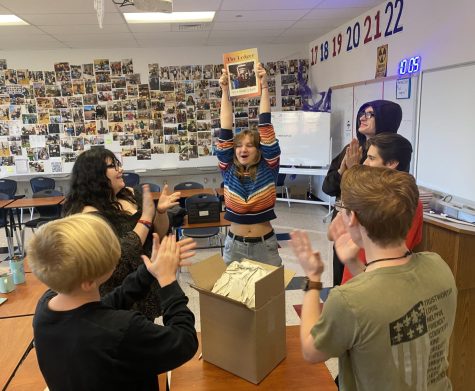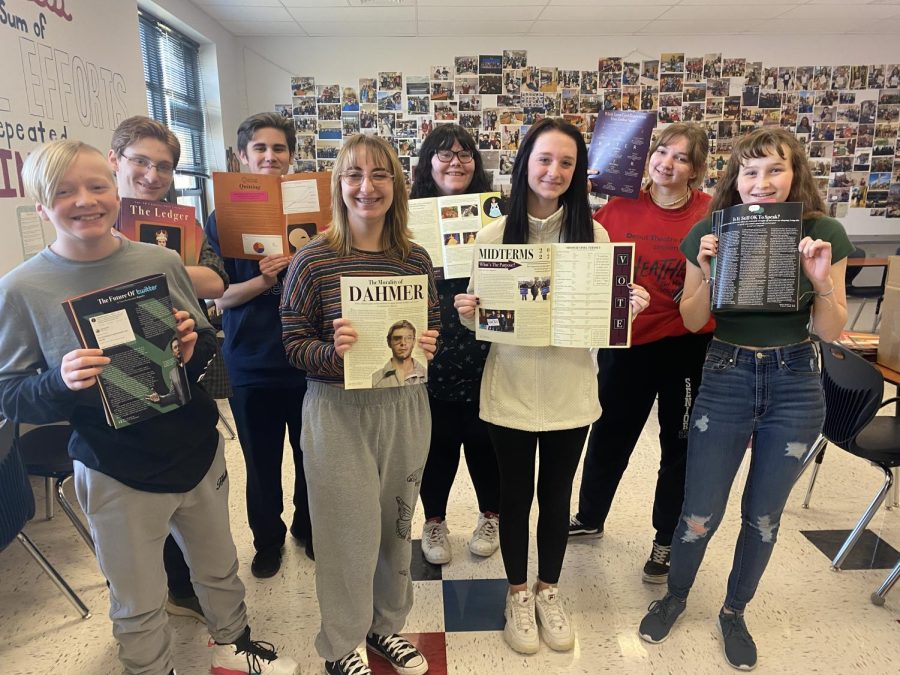The Ledger in Process
The Ledger staff works year-round to produce four magazines for the Liberty community
The Ledger staff stands with their pages from issue 2 entitled “InJustice For All.”
March 13, 2023
The Ledger magazine is a staple of the Liberty publications program. People all over the school read the magazine each quarter a new issue releases. Every magazine is filled with unique stories and incredible designs from the minds of the magazine crew.
But this begs the question, how is the magazine created? There are many components in the magazine creation process that bring you the incredible issue that releases every quarter. It all happens in the magazine class where the creative minds of the students and editors come together and collaborate.
One of the first things the magazine crew does every year to ensure consistency throughout each issue is giving the yearly volume a theme. Each theme has so far been consistent with the number four. Last year’s theme featured the four elements: earth, water, fire and air. This year’s is the four cardinal virtues: fortitude, justice, temperance and prudence.
Once a theme has been picked by the editors, each magazine will have many choices for titles but only one will get picked for each issue. All titles are carefully created to go with the theme of that issue. A color palette will also be made by the layout editor to go along with each theme. The color palette will be the same and consistent throughout the issue. This also keeps pages from being very different in appearance.
Stories in the magazine are always diverse and have reactive potential for an amazing design. Editors always get to choose what stories go in the magazine. Most of the time these stories will be stories that are written in between magazine issues so students can stay updated on more recent events. Once editors have their list of what stories they have for the upcoming issue, the rest of the crew gets to decide on which pages they would like to design.
The most creative and appealing part of the magazine is of course the remarkable designs each student puts out onto each page of the magazine. The designing process will last around two weeks so the crew has all the time they need to put the pages together. Students will design one or even two pages.

Now this begs the question, how are pages designed? Each member of the magazine crew will use the same design application: Adobe InDesign. Adobe InDesign allows us to create pages using a very advanced program. This lets each member run wild with their ideas and imagination. On Adobe InDesign there is little to no restriction on placement, creating shapes, font styles and much more.
Everyone puts thought and hard work into their creations of each page for those two weeks. The color palette additionally becomes a large part of each page, as well for the consistency of that issue. Once the pages are finished, they are printed and checked by everyone for mistakes or suggestions in a process called group edits. After group edits are complete, the editors will do a final review of each page and input any finishing touches.
After this is all done for the issue, the final design of all pages will be sent out to The Missourian so they can be officially printed and put together. Around a week later, the magazine crew will be delivered several boxes with loads of issues in every one. Then every member will distribute the magazine throughout the school. The magazine will be delivered to classrooms, stands and other areas in the school.
This process will repeat for each issue. After the magazine has finally been released, the crew will take a break in between the issues by writing up a few stories for the website.
It’s truly a lot of work for the magazine crew and how they all get it done so quickly. Thought, hard work, and lots of determination is what keeps this crew of incredibly creative people going.
Students can find the The Ledger magazine in the stands and classrooms around school, or they can read virtual copies of the magazine class’s work using this link.









